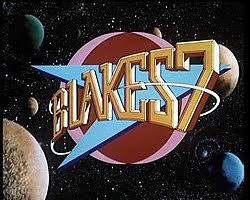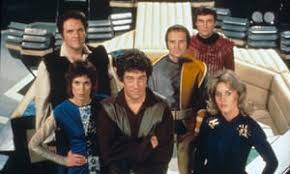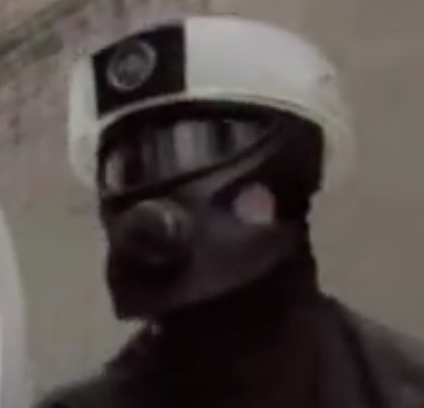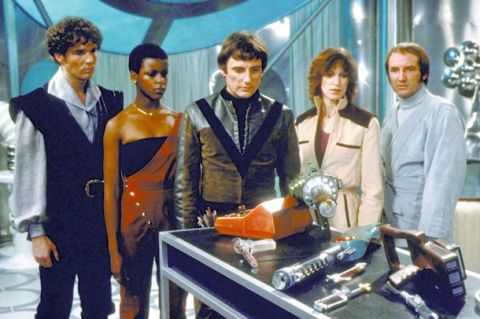IMDb meta-data is 52 episodes of 50 minutes each, overrated 8.0 by 2712 cinemitizens.
Genre Sy Fy.
Verdict: Improves after episode 1.1 thanks to writer Terry Nation but pales then without Terry Nation.
The director(s) need masterclasses from Val Guest. It is evident more money was invested in Seasons Two to Four in costumes, sets, and stunts. Then it goes on and on without Blake and without ever making it to seven.

It first aired the same week that ‘Star Wars’ opened in England. There are similarities and differences. The technical effects of ‘Star Wars’ outstripped everything at the time including this.
The similarities are in the story. Both feature a small band of righteous outcasts who challenge a behemoth. In the case of ‘Star Wars’ the band members cooperate, some friction aside, and prevail over the mighty, whereas in ‘Blake’s 7’ the members quarrel constantly, to the point of tedium, well, far past the point of tedium, and lose slowly but inevitably everything (including viewer interest).
The sequence of my viewing got jumbled but that did not seem to matter after the second season when any sense of a quest with a chronological order was lost and it reverted to swords and sandals in space with a new wardrobe each week. Blake departs but the name stayed.
In the far future (or past) the Terran Federation is a nightmare of McKinsey Micro Managers with Macro tasers. Things are worst on the home world of Earth where it all started. There micro-management involves brain washing. Today’s managers can only dream of this, and some do.
Malcontents who failed 360-degree reviews, missed the KPIs, or used plain English instead of deracinated McKinsey-speak are consigned to transportation to Au-star-lia in the far distant Botany Way. En route the prison ship encounters a Marie Celeste spaceship of an unknown design and it is big. Space is always crowded. Cannot go anywhere without running into an obstacle.
The Big Ship is ominously silent and the first boarding party goes that way, too: Silent. The captain of the prison ship decides to use some expendable prisoners to explore and secure the ship. Genius! He sends Blake because he is a pain and might get toasted; Plucked Eyebrows because she is a pilot who could steer it; and Nasty because he is a computer plumber who might be able to start it. Of course if they succeed ….
Thanks to his heroic self-control with which the script endows Blake, he zaps the self-defence systems of the Big Ship, whose computer then politely introduces itself as Zen, Siri’s cousin, and the ship as Liberator, and off they go.
In this case, bigger proves to be better. BIG disappears, leaving far behind the prison ship and its many keyboards which the actors pound with hammers. The prison ship captain is sure now to fail his 360-degree review. Gulp!
Blake has two then. ‘Blake’s 2’ did not cut it as a title. The fraternity brothers thought it could be ‘Blake’s 3’ by counting the man himself. Not so, a higher authority ruled. Blake’s One does not count. That one is covered with just the word ‘Blake.’ There are many convoluted discussions in the cyber world about this very deep and perplexing question. Abandon syntax all who would plumb those depths.
 Blake and five makes six.
Blake and five makes six.
By the way, the opening title card from Beeb above has no, repeat no, possessive apostrophe. It reads ‘Blakes 7.’ In fact it reads ‘Blakes7’ without a space between the word and the number. Grammar, too, must be abandoned it seems. Some wits and wags say those omissions were due to budget constraints. Neither apostrophe nor space could be afforded. Silly? Maybe not. If the title card and publicity material were done by mistake without the apostrophe and space, the budget might not have been sufficient to do them again. The IMDb in a rare display of grammar has inserted an apostrophe and space on its entry for this series which reads ‘Blake’s 7.’ As did I above.
The pilot seems willing to do what Blake wants. (The fraternity brothers made several suggestions.) Nasty wants to… be…nasty. They decide to follow the prison ship to the prison world and rescue any other prisoners who want to come along. Why? Because the title calls for seven, that is why. Yes, Blake says it takes seven to fly BIG but in fact there are never seven at a time on BIG. Moreover, every time something comes up, they run back and forth to the controls. It is clear to everyone but Blake that more than 7 are needed. However, often the ship, with Zen at the helm, flies itself and 0 are needed. At no time are there seven (7) on board flying Liberator.
These three show no curiosity about BIG or its absent crew, but find plenty of wardrobe that just happens to fit each of them. Go figure. The threads by the way are strictly Robin Hood. At least they are not flared trousers. No one stops to think that may BIG’s people will come looking for it with BIG things. This they do in the opening of Season Two with decals stuck on their foreheads and even worse dialogue. It is this episode the Nasty says, ‘Beam me up!’ Whoops. Ditto in this episode Blake says we call the ship ‘Liberator.’ Read the script, lad. Zen told you the name of the ship was Liberator in episode 1.1. It calls itself that. And the interrogator, even without a waterboard, should have already known all that since they came to reclaim the ship. Does anybody reads the syllabus, eh, script?
Thereafter they argue among themselves as their number increases toward but never attaining the magnificent but elusive seven. Mostly the tension is between Blake who wants to subvert the McKinsey Terrans with rebellion and Nasty who wants to enrich himself. We have action man who wants to blow things up versus the hacker. Blake’s merry band includes a strong man who can throttle villains two at a time, a cringing coward who can pick locks, a rebellious young woman who wants to do things her way, and someone I have forgotten. Or should that be two? By Season 1, Episode 6 they are Blake and four others.
Is Siri, the talking computer Zen, number 7? Stay tuned to find out! I did, stay tuned, and I didn’t, find out. Later we have another talking computer.
They are opposed by passing pirates, nut cases, Brian Blessed as a crazed Holy Roller, and pursued by McKinsey Operatives with Power Point lasers and training modules. Though these official pursuers are easy to elude because they wear blinding head gear which they only remove so they can clonked on the head.

If the director ever lets them take off those tin cans, Blake’s Seven will be None, Zero, Nada, Gone.
Blake emotes over microbes, broken pottery, litter on the spaceways, and is always going out of the way to get into trouble as required by the script. He is Mother Teresa in space.
The characters do not change though some are killed off and others just disappear. The pilot continues to do as told. Nasty remains nasty. The coward cringes when a draft blows. The strong man rips the top off tins when a can opener is handy. Blake emotes. It is all predictable. Scanners reveal a banana peel floating in space. Blake has to stop and collect it in case a passing ship slips on it. Nasty objects that doing so is a waste of time. Wimpy hides in case a chimpanzee comes looking for the banana. Pilot does as told. Petulant female pouts. Strongman stomps on it. The end.
By the end of season four only Nasty and the Coward remain from the original crew, a]having repeated their paper thin characterisations fifty-one times.
Strangely, Blake is in less than half the episodes. The question then is, who does the emoting if he is not there? When he is absent the crew goes looking for him but not very hard. Maybe he got a better offer, I know I did. Should the title have change to….? ‘7 without Blake?’ Or, how about, ‘Blakeless7.’
 Five without Blake.
Five without Blake.
Most episodes of the first two seasons are bleak, and the fraternity brothers proposed it be renamed ‘Bleak 7’ and obviate the need for an apostrophe. There is never have a Zorro moment, and they leave a trail of destruction behind them, despite their intentions. The distant, space-powered future is worse than today. In most episodes they encounter malign beings and occasionally they turn on each other.
By the by, Nasty is called Avon. Yes he is. And yes he does….once, say into the communicator ‘Avon calling.’ I waited fourteen episodes for the moment. But it was anti-climactic, because Paul Darrow says it like he means it. What an actor! It became his show when Blake went missing. But how can Nastyman carry the show. Answer, he couldn’t.
There are some interesting ideas sprinkled throughout, and occasionally some fine acting. Ideas? The chair sized computer shrank itself to fit into a pocket. The idea that a universally used computer chip in the Federation can be hacked by the largest portable computer ever seen, Oric, was prescient. However in the kickoff to Season Two when The System comes to reclaim Liberator it seems computers there also use that chip. How can this be since this is the first contact between the Federation and The System is anyone’s guess. The fraternity brothers were sure of this, because those forehead decals are memorable.
While the fount, Wikipedia, reports a steady fall in audience from Season One to Two, the budget increased as evidenced by the every more expensive wardrobe, costumes, and stunts. The designers were also called to create new sets for new villains. The money went to these superficial bibelots and not to screen writing. Terry Nation’s name is seen less often in the credits. At one point it seems the script writer also plays a part. Never a good idea.
Good acting? Well, none of the regular and fabled ‘7,’ if ever that number was reached qualify largely because the scripts give each of them only one note, but Space Commander Travis in the first season has some moments in the last episode of real complexity. However this actor was replaced by Travis II who is one-dimensional. Avon certainly tries to inject gravitas into the limp scripts.
Blake had a long career in Brit TV, including — of course — ‘Midsomer Murders,’ but this series is listed as one of his three ‘Known For’s’ on the IMDb. Since it is virtually unknown that is little consolation.
I watched some of the early episodes at the time with only a vague recollection, but I did not follow the series to the end. That was not an aesthetic decision but a result of travels on sabbatical 1979-1980.
Skip to content
